TPO -> TPOs of Finland
TPOs of Finland
By Tony Goodbody
The earliest Finnish TPOs date from 1870 and were inscribed in Swedish. From 1894 Russian text was added and from 1902 some postmarks were inscribed in Finnish as well. From 1918 they were inscribed in Finnish and Swedish or Finnish only.
There were 54 numbered routes and some of these had a great many types of postmark. Route 1 had 34 types and route 2 had 41, not all of them in general use. The higher numbered routes had fewer varieties of postmark but the total number of postmarks runs to several hundred, some of them very rare.
Illustrated here are a few of the types most commonly encountered. A list of inscriptions together with translations is to be found on the Railway Philatelic Group site under the section "Terms and Abbreviations."
Period 1 - 1870-1893
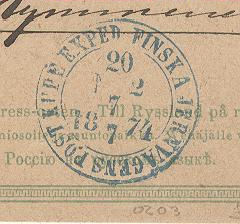
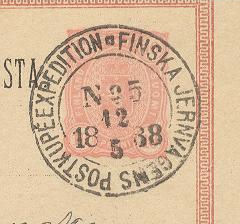
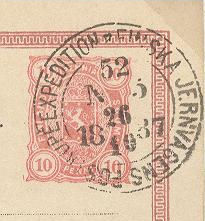 |
||
| Figure 1 | Figure 2 | Figure 3 |
The postmarks in figures 1-4 are all inscribed in Swedish: FINSKA JERNVAGENS POSTKUPÉ EXPED (Literally "Finnish Railway Posting Forwarding Mail Van").
Figure 1 shows a postmark used on Route No.2 (Helsinki - St. Petersburg) struck in green. The number (20) above the date indicates the station of posting (Utti). It is not always easy to assign a station to a number because the numbering changed from time to time, as, for example, when a new intermediate station was opened. Figures 2 & 3 show postmarks from route 5 (Helsinki - Turku), one of them from station No. 52 (Loimaa).
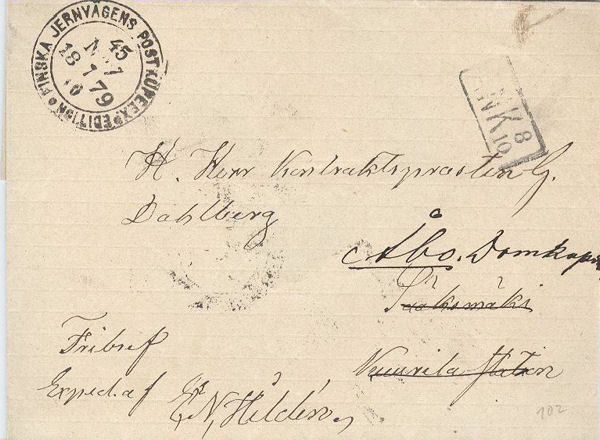
Figure 4 shows an entire letter posted on route No. 7 (Helsinki - Turku) at station No. 45 (Toijala)
Period 2: 1894-1918
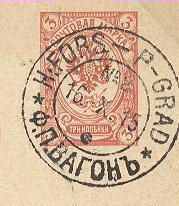
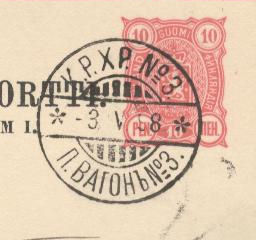
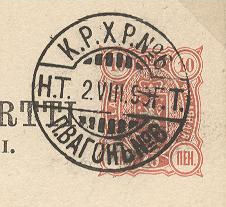 |
||
| Figure 5 | Figure 6 | Figure 7 |
Figure 5 shows a postmark for route No. 2 inscribed in Swedish (HELSINGFORS - PETROGRAD) and Russian. The Russian text in the lower rim reads: ф.П.ВАГОНЪ (финСкА ПОЧТОВЫЙ ВАГОНЪ): Finnish Postal Wagon. The closed symbol (➊) below the date indicates a night train. An open circle (О) would have indicated a day train.
Figure 6 shows a postmark from route No. 3 (Helsinki - Turku) with the Swedish inscription K.P.X.P. (KUPÉPOSTEXPEDITION): and the Russian П.ВАГОНЪ as for figure 5.
A variation on figure 6 is shown in figure 7. The letters H.T., Т.T. either side of the date indicate the route: Helsinki - Tampere. There is no equivalent of the letter 'H' in the Cyrillic alphabet so Helsinki (or Helsingfors) becomes ГЕЛЪСИНГфОРСЪ.
Period 3: 1918 - ?
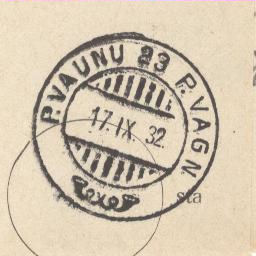
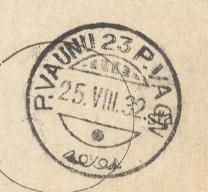
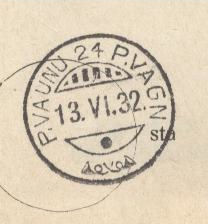 |
||
| Figure 8 | Figure 9 | Figure 10 |
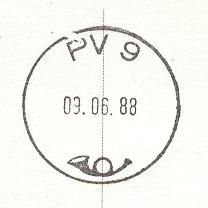 Postmarks from the period between the wars are very much more difficult to find in good condition and collectors usually
have to be satisfied with inferior copies. The postmarks shown in figures 8 - 10, inscribed in Finnish and Swedish,
are taken from letter bills for routes 23 & 24 (Savonlinna - Haapamäki & vv). Again figures 9 & 10 have the symbol for a night train.
Postmarks from the period between the wars are very much more difficult to find in good condition and collectors usually
have to be satisfied with inferior copies. The postmarks shown in figures 8 - 10, inscribed in Finnish and Swedish,
are taken from letter bills for routes 23 & 24 (Savonlinna - Haapamäki & vv). Again figures 9 & 10 have the symbol for a night train.
During the closing years of TPO operation the postmarks were distinctly "minimalist". Route No.9 (figure 11) was the postmark for the route HELSINKI - KUOPIO.
Mailguards
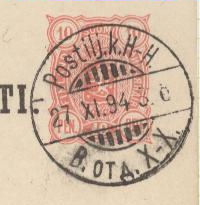 The term for a mailguard is Postiljonskupéer (Swedish) or Postiljoonivaunu (Finnish). The postmark in figure 12 is inscribed in
Swedish and Russian: Postilj.k. H-H/ B.OTД. X-X. The route is HANGÖ - HYVINGE (Swedish) or HANKO - HYVINKÄÄ (Finnish).
The Russian inscription, B.OTД is short for BAГОНЪ OTДВЛЕНЕ
the literal meaning of which is separate van.
The term for a mailguard is Postiljonskupéer (Swedish) or Postiljoonivaunu (Finnish). The postmark in figure 12 is inscribed in
Swedish and Russian: Postilj.k. H-H/ B.OTД. X-X. The route is HANGÖ - HYVINGE (Swedish) or HANKO - HYVINKÄÄ (Finnish).
The Russian inscription, B.OTД is short for BAГОНЪ OTДВЛЕНЕ
the literal meaning of which is separate van.
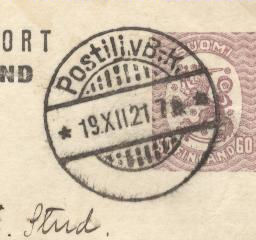 Figure 13 shows a postmark from the BORGA - KERAVA route. This is inscribed in Finnish (k after "Postilj." is replaced by v).
The Russian in the lower rim has been excised.
Figure 13 shows a postmark from the BORGA - KERAVA route. This is inscribed in Finnish (k after "Postilj." is replaced by v).
The Russian in the lower rim has been excised.
Bibliography:
1. Franklin, N.C. 'Finnish TPO Cancellations 1872-1917.' Illustrated, b/w, 9pp.
2. Scandinavian Contact, Volume 11, No.6, pp182-191, 1983. Simplified treatment in English.
3. Kidd, C. 'Railway Post Offices of Finland.' Illustrated, b/w, 17pp.
4. TPO Journal: Vol.37, No.4, pp81-91; Vol. 38, No.1, pp17-20; Vol. 38, No.2 pp40-42; Vol. 38, No.4, pp83-84, 1983/4.
This is the most accessible treatment and is of Cyril's usual high standard. Many more postmarks are illustrated here.
5. Tielinen, Y.E. 'Postivaunujen No. (xx) leimat.' (Postal Wagon No. (xx) cancels.) Illustrated, b/w, 28pp.
Published serially in a Finnish philatelic magazine, 1972-1975 (one part probably published in 1967.)
Definitive listing of Finnish TPO marks. Every type of mark for each route is listed chronologically and numbered,
with text, dates of use and identifying characteristics. Complete to early 1950s.

